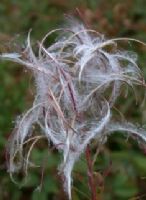

|
|
|
Rosebay Willowherb Rosebay Willowherb Date added: 10/08/2022 17:38:57 Epilobium Angustifolium also Chamaenerion Angustifolium. If you visit the cemetery today you might think that we are well into autumn instead of high summer. Many flowering plants are already over and those that remain are stunted and poor because of heat and drought. However, in the north-west area you will find a bright splash of colour. Rosebay Willowherb is a tall, vigorous perennial and can reach 2 metres in height flowering from June to September. The flowers are magenta to pink, each having four slightly asymmetric notched petals. After flowering, the long seed pods split and curl into four and release numerous minute brown seeds which have long silky hairs to aid wind dispersal . Each plant may produce up to 80 thousand seeds. It is found in many different habitats including damp soils, heathland, urban sites such as railway banks and waste ground. Following World War 2, it rapidly colonised bomb sites which led to it being called ‘Fire Weed ‘or ‘ Bomb Weed’. In 1941, during the Clydebank Blitz, the Singer sewing machine factory was bombed and Willowherb quickly became established on the site and came to be called ‘Singer Weed ‘locally. Another nickname, (from Dorset) was ‘Plum Jam’ and yet another was ‘St. Anthony’s Laurel’. This last one is possibly related to the fact that the plant had many old medicinal uses, especially for treating skin conditions and this saint is venerated for his help for such problems. The leaves, stems and shoots have been cooked and eaten in the past and the flowers, also edible, may be used to brighten a salad. From the 13th century the leaves were used in Russia to make a black tea called Ivan chai or Koporye tea. The flowers also provide a good source of nectar for honeybees, bumble bees and solitary bees which are all valuable pollinators. Apparently, it is also eaten by bears and elks so you might like to send us an email if you happen to see these in the cemetery! © FNRC
Images related to this news article |
Website designed and maintained by Paul Thompson on behalf of the Friends of Newtown Road Cemetery.

